Raptor easily blows through 14-inch snowstorm
Filed under: Weekly test drives, Autos
By John Gilbert
Opinions mean everything when you’re evaluating vehicles, and that’s OK, and long as those opinions are come by with honest objectivity. And, as long as you’re flexible enougb to change your opinion. You could say I prefer most cars to most trucks, and I prefer most blue paint jobs to most red, yellow or any other.
And then, at the height (depth?) of this winter’s heaviest cold and snow season in Duluth, Minnesota, I had the chance to test a new Ford Raptor pickup. The Raptor identity came on the full-size F150, and even though Ford is branching out with the popular stability and handling variations of the Raptor on other vehicles including the Ranger and the Bronco, this one was the newest versin of the vintage F150 full-sized vehicle.
It arrived on a nice, calm winter day to our home up the hill from the North Shore of Lake Superior, but it didn’t stay nice or calm for long. As the wind carrie the storm out over the Big Lake, then circled back to hit and rehit our area, we wound up with an overnight snowfall of 14 inches. Then the temperature dropped below zero, as if to torment us because the snow itself was pretty light and fluffy, and we weren’t destined to have it easy.
I hadn’t really had the chance to drive the Raptor the first day, but the chance — and some pretty convincing evidence on its behalf — came on Day 2, when the true benefit of a full-size pickup truck hit me right between the eyes.
The evidence started piling up, you should pardon the expression, when I first climbed up into the Code Orange Ford Raptor. The color alone made the Raptor graphics stand out, and the truck is tall enough to stand out above the deepening snow in our driveway.
But for once, I had a cavalier attitude about the snow. I just didn’t care, because I knew this F150 Raptor was raised, widened, and had beefed-up suspension to take on any task on or off road. Or in knee-deep snow.
It was an easy step up, out of the fluffy white snow and onto the fixed cast-aluminum running board, while vaulting hips-first into the very stark and very wide, interior of Ford’s hottest performance pickup. Looking ahead up my 100-yard driveway I could see the 3-foot high ridge of snow left by the county plow guy, I still didn’t care, although my adrenaline started to rise at the obvious challenge, as I pushed the right button to bring the 3.5-liter twin-turbocharged V6 roaring instantly to meaningful-sounding life.
Instantly, the image came to mind of the Raptor saying, “This? This is nothing!” as it snarled to life in the 10-below temperature. I gave it a minute while I checked out all the controls. Then I shifted to “D” and away we went, breaking our own new trail through the snow and whumping through the plow’s pile to blast onto our rural roadway. It’s hard to believe the Raptor began life as a Ford F-150 before getting the Raptor treatment of a widened platform and all sorts of beefed-up, oversized suspension, exhaust, engine, transmission, ground clearance and other alterations to make it better suited to conquer the worst off-road conditions.
In Duluth, Minnesota, the definition of bad conditions needn’t be just off-roading fun, because it can also mean treacherous driving to and on roadways because of large snowfalls that seem to be particularly common this winter of 2021-22.
That’s why the revelation hit me. Yes, I like cars in most instances over the huge array of trucks and SUVs, but when you think about it, when five months of your year might face a dozen criticial wintry threats, having a truck makes a lot more sense than for city-dwellers who just “want” a truck. And if you’re getting a truck, you might want the industry’s standard killer truck for all purposes. And if that means you choose the Ford Raptor, then why not also get it in Code Orange, a bright, flashy paint scheme that is peppered with black decal styling items that indicate to all the world that your super truck is, indeed, a Raptor.
With specific running lights on the top edge of the big grille, with the huge letters “F-O-R-D” covering the full width, there’s no chance anybody will mistake what’s coming at them. Also, if somebody crashed into the Code Orange Raptor, they’d have to be trying to. No failure to see this beast approaching could be called accidental..
So many “locals” have big pickups that are justified by a tendency to tow a boat or snowmobile trailer up to the cabin, nobody questions the decision. Among all the adjustments possible is a mode switch to set at Normal, Sport, Baja and Quiet. If you suffer from an overdose of macho, going from sport to Baja focuses everything including the exhaust to declare your intentions, and if you have no macho tendencies, I guess you could select normal, but I’m not sure that anybody worth the $78,545 sticker price would click it into quiet.
It is interesting that Ford chose to build a new platform and arm the newest version of the Raptor with enormous off-road tires and a specially-designed Fox Shock absorber system to help showcase the new five-link coil rear suspension and long rear coil springs to all help getting the bolstered power delivery from an estimated 450 horsepower and 510 foot-pounds of torque to the ground, whether it be street or rocky terrain.
Part of the improvements at every part of the Raptor has to be the challenge from the Ram TRX, a new rival to Raptor’s domain. But what is most impressive about the Raptor’s obvious off-road capabilities are that they don’t turn the Raptor into a heavy-duty pogo-stick on rough streets.
We found the seats very comfortable and supportive, but driving over weather-battered streets and construction zones never caused any harshness or discomfort, and we would have to say the new Raptor is over-built for normal trips to Target or the grocery store. Comfort, meanwhile, is everywhere for five occupants in the Super Crew 4×4 — the only version of the F-150 that can become a Raptor. Such features as a potent audio and a large information screen on the dash lead to the logical inclusion of all the connectivity and media features, as well as controls for the requisite camera views for parking and maneuvering aid.
For those who do work from their trucks, the Raptor has Ford’s trick console, with a fold-down shift lever, and a flip-over lid that turns into a desk, and reveals a deep, cavernous bin for hanging files to organize your next construction job. With all that, the Raptor is maneuverable and easy to handle, even in congestion where the wider body might seem a problem.
Rumors persist that Ford is already planning for increased challenges, starting with building a Raptor version of the Ranger, and next supplying the new Maverick compact truck with a Raptor model, as well as the new Bronco, which has a half-dozen different models, so why not a Bronco Raptor? But the F-150 Raptor may be about to add a V8 just in case Ram or anybody else tries to outdo the current Raptor’s power.
Me? The 3.5-liter twin turbo V6 is more than adequate, and it works well with the 10-speed automatic, and all those trick suspension pieces that help lift the beast higher than its ground clearance can handle. That would be a lot, because it currently has 14 inches of front travel and 15 inches in the rear.
That’s plenty for conquering the biggest off-road challenge you might be able to locate.
And for sure, it makes a foot-deep snowfall or a waist-deep snowplow ridge no challenge at all.


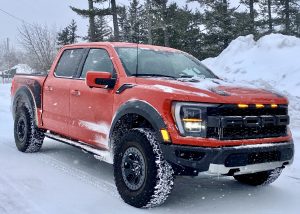
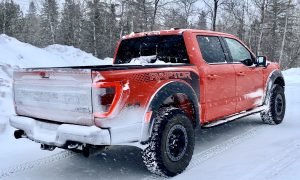

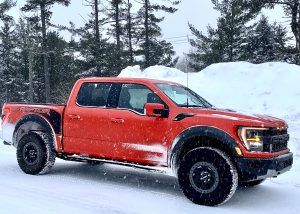
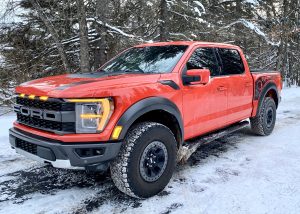
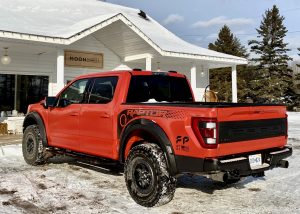
 John Gilbert is a lifetime Minnesotan and career journalist, specializing in cars and sports during and since spending 30 years at the Minneapolis Tribune, now the Star Tribune. More recently, he has continued translating the high-tech world of autos and sharing his passionate insights as a freelance writer/photographer/broadcaster. A member of the prestigious North American Car and Truck of the Year jury since 1993. John can be heard Monday-Friday from 9-11am on 610 KDAL(www.kdal610.com) on the "John Gilbert Show," and writes a column in the Duluth Reader.
John Gilbert is a lifetime Minnesotan and career journalist, specializing in cars and sports during and since spending 30 years at the Minneapolis Tribune, now the Star Tribune. More recently, he has continued translating the high-tech world of autos and sharing his passionate insights as a freelance writer/photographer/broadcaster. A member of the prestigious North American Car and Truck of the Year jury since 1993. John can be heard Monday-Friday from 9-11am on 610 KDAL(www.kdal610.com) on the "John Gilbert Show," and writes a column in the Duluth Reader.